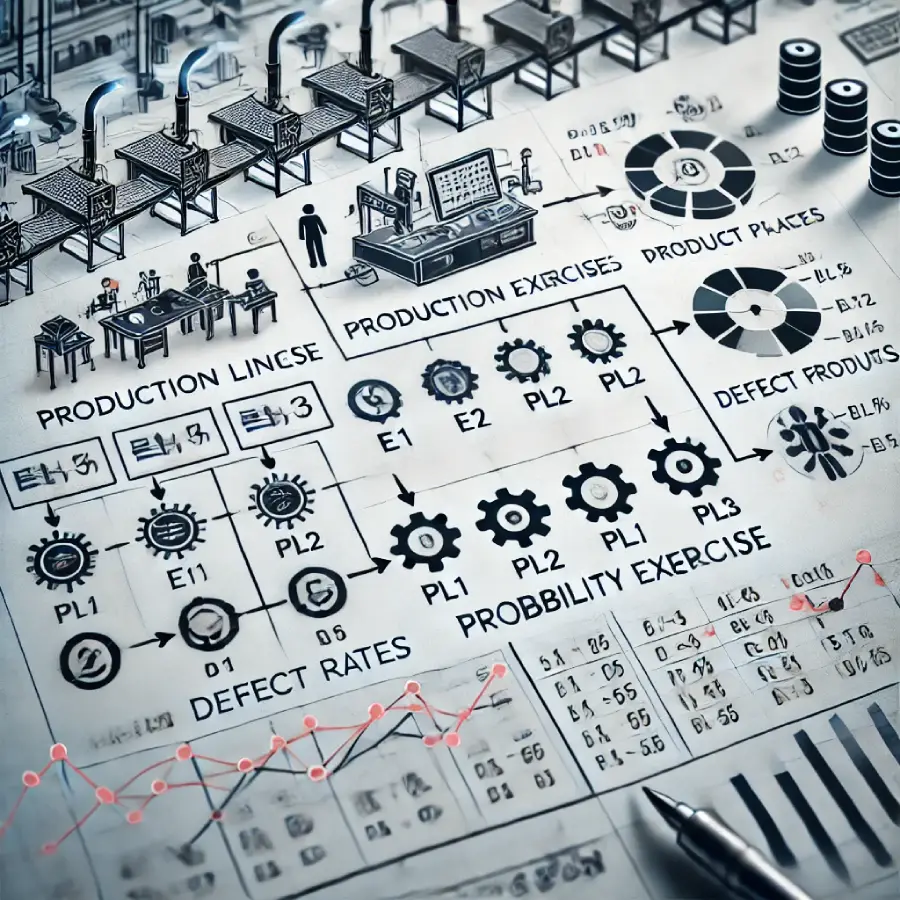Exercise
In a factory producing electronic components, there are three production lines: PL1, PL2, and PL3. The quality control process classifies defective products into two categories, E1 and E2, based on the percentage of defect correction needed for the product. The table below shows the distribution of 1,620 defective products across the three production lines and the two defect categories:
| PL1 | PL2 | PL3 | Total | |
|---|---|---|---|---|
| E1 | 220 | 370 | 180 | 770 |
| E2 | 180 | 420 | 250 | 850 |
| Total | 400 | 790 | 430 | 1620 |
Answer the following questions:
1. Evaluate the probability that a product comes from production line PL1 and belongs to category E2. Are these two independent events?
2. Calculate the probability that a product belongs to category E1 or comes from production line PL3.
3. Calculate the probability that a product does not belong to category E1 and does not come from production line PL1.
4. Calculate the probability that a product belongs to category E2, given that it comes from either production line PL2 or PL3.
—
Solution
Let’s solve each question step by step.
Question 1: Probability that a product comes from PL1 and belongs to E2.
We need to calculate \( P(\text{PL1} \cap \text{E2}) \).
\[
P(\text{PL1} \cap \text{E2}) = \frac{\text{Number of products in PL1 and E2}}{\text{Total number of products}} = \frac{180}{1620} \approx 0.1111
\]
To determine if these two events are independent, we check if \( P(\text{PL1} \cap \text{E2}) = P(\text{PL1}) \times P(\text{E2}) \).
\[
P(\text{PL1}) = \frac{\text{Number of products in PL1}}{\text{Total number of products}} = \frac{400}{1620} \approx 0.2469
\]
\[
P(\text{E2}) = \frac{\text{Number of products in E2}}{\text{Total number of products}} = \frac{850}{1620} \approx 0.5247
\]
Calculate \( P(\text{PL1}) \times P(\text{E2}) \):
\[
P(\text{PL1}) \times P(\text{E2}) = 0.2469 \times 0.5247 \approx 0.1295
\]
Since \( P(\text{PL1} \cap \text{E2}) \neq P(\text{PL1}) \times P(\text{E2}) \), the events are not independent.
Question 2: Probability that a product belongs to E1 or comes from PL3.
We need to calculate \( P(\text{E1} \cup \text{PL3}) \).
\[
P(\text{E1} \cup \text{PL3}) = P(\text{E1}) + P(\text{PL3}) – P(\text{E1} \cap \text{PL3})
\]
Where:
\[
P(\text{E1}) = \frac{770}{1620} \approx 0.4753, \quad P(\text{PL3}) = \frac{430}{1620} \approx 0.2654
\]
\[
P(\text{E1} \cap \text{PL3}) = \frac{180}{1620} \approx 0.1111
\]
Substitute into the formula:
\[
P(\text{E1} \cup \text{PL3}) = 0.4753 + 0.2654 – 0.1111 \approx 0.6296
\]
Question 3: Probability that a product does not belong to E1 and does not come from PL1.
We need to calculate \( P(\overline{\text{E1}} \cap \overline{\text{PL1}}) \).
\[
P(\overline{\text{E1}}) = 1 – P(\text{E1}) = 1 – 0.4753 = 0.5247
\]
\[
P(\overline{\text{PL1}}) = 1 – P(\text{PL1}) = 1 – 0.2469 = 0.7531
\]
The number of products that are not in E1 and not from PL1 is equal to the number of products in E2 from PL2 and PL3:
\[
P(\overline{\text{E1}} \cap \overline{\text{PL1}}) = \frac{420 + 250}{1620} = \frac{670}{1620} \approx 0.4136
\]
Question 4: Probability that a product belongs to E2, given that it comes from either PL2 or PL3.
We need to calculate \( P(\text{E2} \mid \text{PL2} \cup \text{PL3}) \).
First, find \( P(\text{PL2} \cup \text{PL3}) \):
\[
P(\text{PL2} \cup \text{PL3}) = \frac{790 + 430}{1620} = \frac{1220}{1620} \approx 0.7531
\]
The number of products in E2 from PL2 or PL3 is:
\[
P(\text{E2} \cap (\text{PL2} \cup \text{PL3})) = \frac{420 + 250}{1620} = \frac{670}{1620} \approx 0.4136
\]
Finally, calculate \( P(\text{E2} \mid \text{PL2} \cup \text{PL3}) \):
\[
P(\text{E2} \mid \text{PL2} \cup \text{PL3}) = \frac{P(\text{E2} \cap (\text{PL2} \cup \text{PL3}))}{P(\text{PL2} \cup \text{PL3})} = \frac{0.4136}{0.7531} \approx 0.5493
\]
—
Summary of Answers
1. The probability that a product comes from PL1 and belongs to E2 is approximately 0.1111. These events are not independent.
2. The probability that a product belongs to E1 or comes from PL3 is approximately 0.6296.
3. The probability that a product does not belong to E1 and does not come from PL1 is approximately 0.4136.
4. The probability that a product belongs to E2, given that it comes from either PL2 or PL3, is approximately 0.5493.

